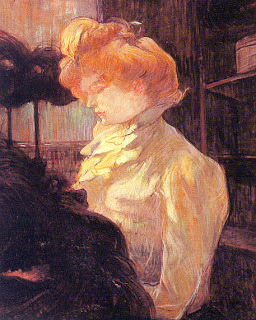 |
Henri de Toulouse-Lautrec
From Wikipedia, the free encyclopedia
| Henri de Toulouse-Lautrec | |
|---|---|
Henri de Toulouse-Lautrec. |
|
| Birth name | Henri Marie Raymond de Toulouse-Lautrec-Monfa |
| Born | 24 November 1864 Albi, Tarn, France |
| Died | 9 September 1901 (aged 36) Château Malromé, France |
| Nationality | French |
| Field | Painter, printmaker, draftsman, illustrator |
| Movement | Post-Impressionism, Art Nouveau |
Contents
|
Early life
Henri Marie Raymond de Toulouse-Lautrec-Monfa was born at the chateau de Malromé near Albi, Tarn in the Midi-Pyrénées région of France, the firstborn child of Comte Alphonse de Toulouse-Lautrec-Monfa and Adèle Tapié de Celeyran. He was therefore a member of an aristocratic family (descendants of the Counts of Toulouse and Lautrec and the Viscounts of Montfa, a village and commune of the Tarn department of southern France). A younger brother was born on 28 August 1867, but died the following year.After the death of his brother his parents separated and a nanny took care of Henri.[2] At the age of eight, Henri went to live with his mother in Paris where he drew sketches and caricatures in his exercise workbooks. The family quickly realised that Henri's talent lay in drawing and painting, and a friend of his father, Rene Princeteau visited sometimes to give informal lessons. Some of Henri's early paintings are of horses, a speciality of Princeteau, and something he later visited in his 'Circus Paintings'.[2][3]
In 1875 Henri returned to Albi because his mother recognised his health problems. He took thermal baths at Amélie-les-Bains and his mother consulted doctors in the hope of finding a way to improve her son's growth and development.[2]
Disability and health problems
Henri's parents, the Comte and Comtesse, were first cousins (Henri's two grandmothers were sisters[2]) and Henri suffered from congenital health conditions traditionally attributed to inbreeding.At the age of 13 Henri fractured his right thigh bone and, at 14, the left.[4] The breaks did not heal properly. Modern physicians attribute this to an unknown genetic disorder, possibly pycnodysostosis (also sometimes known as Toulouse-Lautrec Syndrome),[5] or a variant disorder along the lines of osteopetrosis, achondroplasia, or osteogenesis imperfecta.[6] Rickets aggravated with praecox virilism has also been suggested. His legs ceased to grow, so that as an adult he was only 1.54 m (5 ft 1 in) tall,[4][7] having developed an adult-sized torso, while retaining his child-sized legs, which were 0.70 m (27.5 in) long. He is reported to have had hypertrophied genitals.[8][9]
After failing college entrance exams, Henri passed at his second attempt and completed his studies. During a stay in Nice his progress in painting and drawing impressed Princeteau, who persuaded his parents to let him return to Paris and study under the acclaimed portrait painter Léon Bonnat. Henri's mother had high ambitions and, with the aim of Henri becoming a fashionable and respected painter, used the family influence to get him into Bonnat's studio.[2]
Paris
Toulouse-Lautrec was drawn to Montmartre, the area of Paris famous for its bohemian lifestyle and the haunt of artists, writers, and philosophers. Studying with Bonnat placed Henri in the heart of Montmartre, an area he rarely left over the next 20 years. After Bonnat took a new job, Henri moved to the studio of Fernand Cormon in 1882 and studied for a further five years and established the group of friends he kept for the rest of his life. At this time he met Émile Bernard and Van Gogh. Cormon, whose instruction was more relaxed than Bonnat's, allowed his pupils to roam Paris, looking for subjects to paint. In this period Toulouse-Lautrec had his first encounter with a prostitute (reputedly sponsored by his friends), which led him to paint his first painting of prostitutes in Montmartre, a woman rumoured to be called Marie-Charlotte.[2]With his studies finished, in 1887 he participated in an exposition in Toulouse using the pseudonym "Tréclau", an anagram of the family name 'Lautrec'. He later exhibited in Paris with Van Gogh and Louis Anquetin.[2] The Belgian critic Octave Maus invited him to present eleven pieces at the Vingt (the Twenties) exhibition in Brussels in February. Vincent van Gogh's brother, Theo bought 'Poudre de Riz' (Rice Powder) for 150 francs for the Goupil & Cie gallery.
From 1889 until 1894, Henri took part in the "Independent Artists' Salon" on a regular basis. He made several landscapes of Montmartre. At this time the 'Moulin Rouge' opened.[2] Tucked deep into Montmartre was the garden of Monsieur Pere Foret, where Toulouse-Lautrec executed a series of pleasant plein-air paintings of Carmen Gaudin, the same red-head model who appears in The Laundress (1888). When the Moulin Rouge cabaret opened, Toulouse-Lautrec was commissioned to produce a series of posters. His mother had left Paris and, though Henri had a regular income from his family, making posters offered him a living of his own. Other artists looked down on the work, but Henri was so aristocratic he did not care.[10] The cabaret reserved a seat for him and displayed his paintings.[11] Among the well-known works that he painted for the Moulin Rouge and other Parisian nightclubs are depictions of the singer Yvette Guilbert; the dancer Louise Weber, known as the outrageous La Goulue ("The Glutton"), who created the "French Can-Can"; and the much more subtle dancer Jane Avril.
London
Henri de Toulouse-Lautrec's family were Anglophiles. Though not as fluent as he pretended to be, he spoke English well enough to travel to London.[10] Making posters in London led him to making the 'Confetti' poster,[12] and the bicycle advert. 'La Chaîne Simpson'.[13]While in London he met and befriended Oscar Wilde.[10] When Wilde faced imprisonment in Britain, Henri was a very vocal supporter of Wilde. Toulouse-Lautrec's portrait of Wilde was painted the same year as Wilde's trial.[10][14]
Alcoholism
Lautrec was mocked for his short stature and physical appearance, which led him to drown his sorrows in alcohol.[15] At first this was beer and wine, but his tastes expanded. He was one of the notable Parisians who enjoyed American-style cocktails, France being a nation of wine purists. He had parties at his house on Friday nights and forced his guests to try them.[10] The invention of the cocktail "Earthquake" or Tremblement de Terre is attributed to Toulouse-Lautrec: a potent mixture containing half absinthe and half cognac (in a wine goblet, 3 parts Absinthe and 3 parts Cognac, sometimes served with ice cubes or shaken in a cocktail shaker filled with ice).[16]In 1893 Lautrec's alcoholism began to take its toll, and as those around him realized the seriousness of his condition there were rumours of a syphilis infection.[17] In 1899 his mother and some concerned friends had him briefly institutionalised.[17] He even had a cane that hid alcohol so that a drink was always available.[10]
Death
Toulouse-Lautrec's last words reportedly were: "Le vieux con!" ("The old fool!", although the word "con" can be meant in both simple and vulgar terms[18]). This was his goodbye to his father.[10] Although in another version he used the word "hallali", a term used by huntsmen for the moment the hounds kill their prey, "I knew, papa, that you wouldn't miss the death." ("Je savais, papa, que vous ne manqueriez pas l'hallali").[19]
After Toulouse-Lautrec's death, his mother, the Comtesse Adèle Toulouse-Lautrec, and Maurice Joyant, his art dealer, promoted his art. His mother contributed funds for a museum to be created in Albi, his birthplace, to house his works. The Toulouse-Lautrec Museum owns the world's largest collection of works by the painter.
Art
Toulouse-Lautrec's skilled depiction of people relied on his painterly style which is highly linear and gives great emphasis to contour. He often applied the paint in long, thin brushstrokes which would often leave much of the board on which they are painted showing through. Many of his works may best be described as drawings in coloured paint.


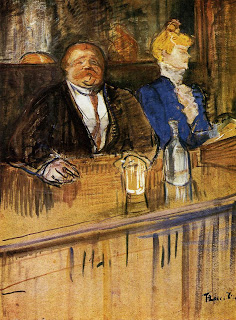
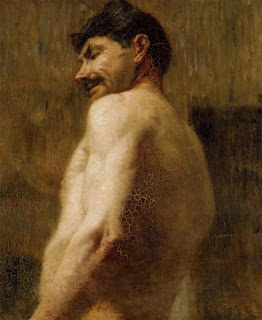


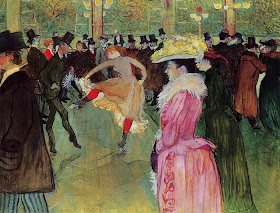




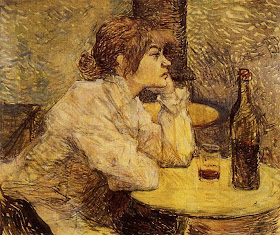




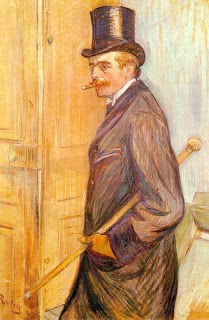








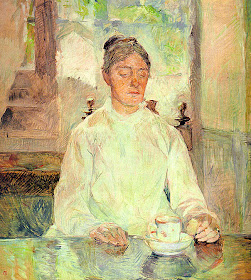


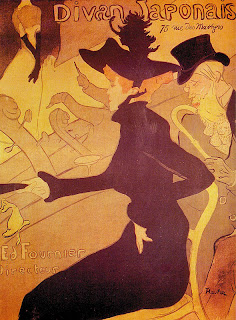
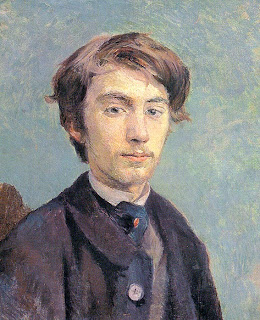
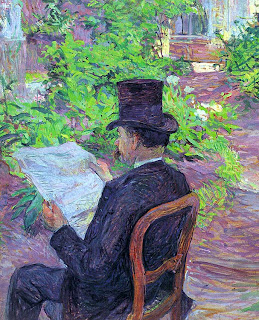



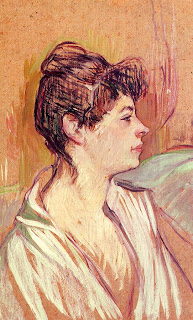


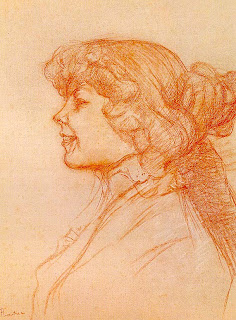


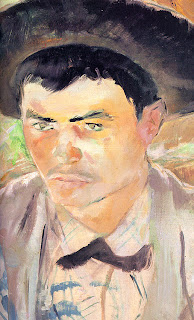




No comments:
Post a Comment